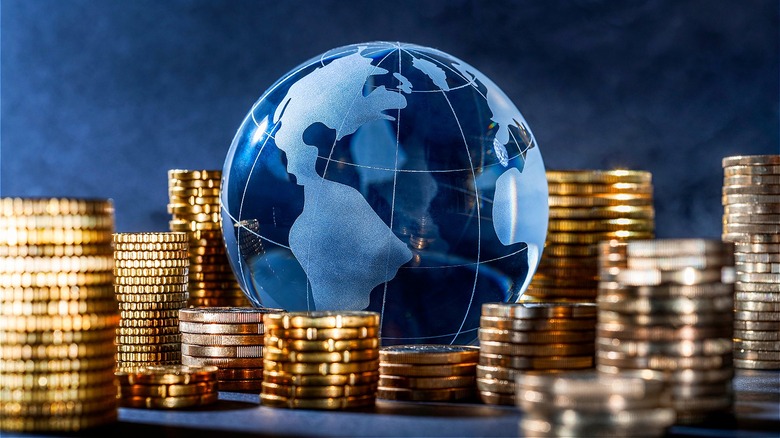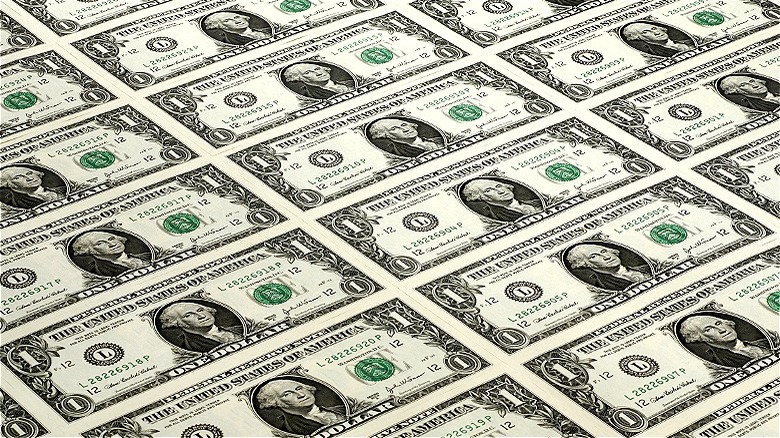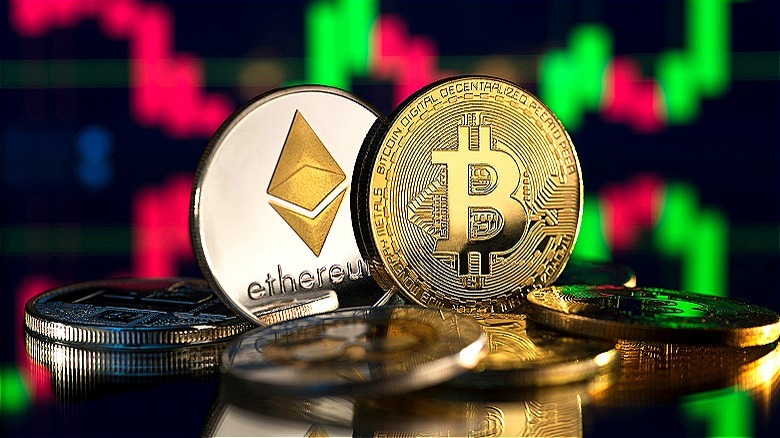Here's How Much Money Really Exists In The World
Before the invention of money, early citizens of the world traded goods and services via the barter system. Those bartered items could include livestock, vegetables, spices, and even weapons. In the 7th century B.C., metal coins were invented in Lydia (modern-day Turkey) and China to facilitate transactions. While carrying around coins was certainly easier than always traveling with a cow to barter, less bulk was still a goal — especially for international trade. That quest for reduced weight eventually led to the development of official paper money in China, around 1020 A.D., during the Song dynasty, though unsanctioned paper trade receipts had existed much earlier.
Nowadays, the term "money" has expanded even further to include things like cryptocurrency and funds held in checking, savings, and investment accounts. Therefore, when considering how much money exists in the world, the answer is going to depend heavily on how broad your definition of money is. But lest we be accused of burying the lede, estimates say there's approximately $83 trillion floating around the globe in either cash, bank accounts, or other instruments that can be converted quickly into cash. With that spoiler out of the way, let's take a deeper peek at the breakdown of the world's money supply.
Liquidity is key when categorizing money
First, let's address the strictest interpretation of money; that is, paper notes and coins. According to the personal finance website GOBankingRates, there's ~$8.28 trillion worth of paper notes and coins in circulation in the world. Per the outlet, this number is based on a 2021 estimate from the Bank for International Settlements. What's more, this money is distributed across some 40 countries, including the 20 countries that use the euro as currency. Since there are more than 200 countries in the world and only 40 are accounted for in this estimate, that $8.28 trillion figure is likely somewhat low, but it's the best guess we have to work with.
If we expand our definition of money to include not only bills and coins, but the balances held in checking and savings accounts, traveler's checks, and other highly liquid (i.e., easily convertible to cash) assets as well, we arrive at what's called the "M1 money supply." Per Visual Capitalist, the global M1 money supply stands at $48.9 trillion as of late November 2022.
Finally, there's the M2 money supply, which includes cash, checking and savings account deposits, and other accounts that are fairly easily converted to cash if necessary, but not intended for everyday transactions. A good example of what's counted in M2 as money are certificates of deposit or CDs, which are meant to be held several months or years until maturity, but could be converted to cash in an emergency. Once again deferring to Visual Capitalist, global M2 is estimated at approximately $82.6 trillion.
What about just US dollars?
If you're wondering about the money supply of U.S. dollars only, the Federal Reserve Bank of St. Louis tells us that as of November 2023, the Monetary Base (aka "M0"), made up of cash and coins only, is $5.7 trillion, while M1 is $18 trillion, and M2 stands at $20.8 trillion. What's interesting of late is that the U.S. money supply is actually shrinking for the first time in nearly 75 years.
According ot Goldman Sachs, the reduction in the nation's domestic money supply is a result of declining consumer savings, coupled with the Federal Reserve reducing the size of its nearly $8 trillion balance sheet. During the COVID-19 pandemic, when extreme stimulus and other emergency financial measures ballooned, both the U.S. money supply and the Fed's balance sheet reached new highs. For reference, the Fed's holdings totaled approximately $4 trillion at the beginning of 2020. That's about half its current size and really emphasizes the extraordinary excess liquidity of the COVID era, which was significantly responsible for causing recent inflation.
The future of money
Revisiting worldwide money supply for a moment, the increased use of credit cards and electronic payments has undoubtedly reduced the use of physical cash. To that end, a handful of countries like Sweden and Japan are jumping on the bandwagon by launching their own digital currencies on a trial basis. The Bahamas is even further along, having recently introduced the world's first central bank digital currency (CBDC), whimsically called the sand dollar. However, even if digital currencies and electronic payments replace cash altogether in the future, the world's central banks will still be able to measure money as they do now.
In case you were wondering how much $83 trillion represents on a per-person basis, the Earth's population is currently about 8.1 billion. That works out to $10,246.91 for every human on earth, if divided equally. Finally, SunnyAvenue, a UK-based purveyor of financial advice, estimates that the world's money supply would tally more than $1 quadrillion if cryptocurrencies were included in the equation. If you're anything like us, you're probably not sure how much a quadrillion is. For the record, it's 1,000 trillion.



